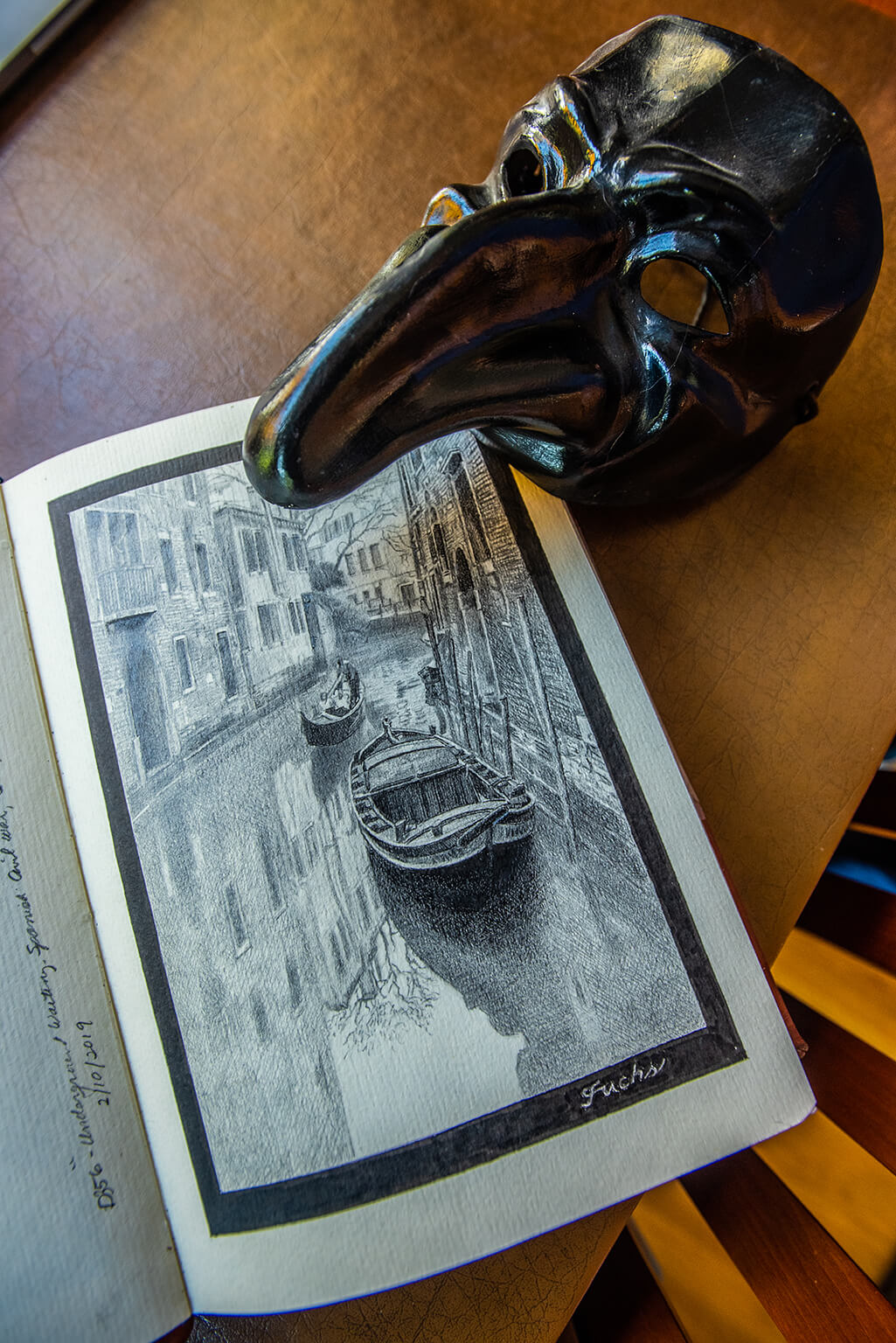Words by Johanna Harlow
If you’ve ever found yourself mesmerized by the undulating, rippling surface of a pond, you’ll likely feel an affinity toward the paintings of Joseph Fuchs. Though water isn’t always featured in the artist’s city and nature scapes, it flows through many of his atmospheric works of art. “Essentially the water is an abstract,” the Los Altos painter describes. “You have to try to get the range of colors and shapes.”
That many of Joseph’s canvases are awash with depictions of bobbing Venetian scenery should come as no surprise. “The first time I went, it was almost like that previous life experience where you walk into a place and you fit… I was more than enchanted!” reflects Joseph, who first fell for Italy’s “City of Canals” back in the ‘80s.
The landscape was quite different from the endless orchards of Joseph’s hometown, where the only action was the occasional groan of a Boeing B-52 coming and going from nearby Moffett Field. As a seventh-generation Peninsula native, Joseph describes the Los Altos of his boyhood as “a drowsy, sleepy place.” “It wasn’t important. It was just a nice place to grow up,” he recollects. “A dog could go to sleep in the middle of the street and never be run over!”
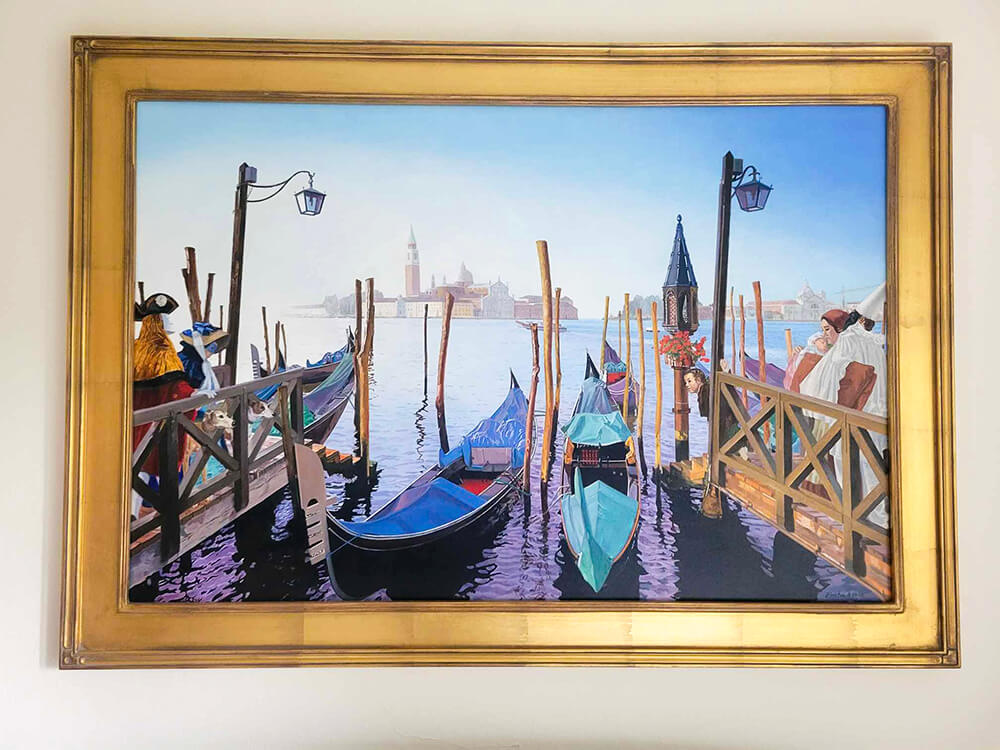
Cover Artwork: Quiet Outing, Venice / Artwork: Floating World
But back to the water and Joseph’s unquenchable wanderlust—because over the years, he’s revisited Venice over a dozen times. “You can go back and see it a second time—and a third and a fourth—and it’s always a little different. And the more you do that, the richer it is,” the octogenarian says.
Joseph, who taught English at Menlo-Atherton High School for 33 years, even spent his six-month sabbatical living there. He painted every morning, then wandered the streets after lunch, returning back again in the evenings. “I would find a direction and just walk,” he says. “I would go different routes every single time.”
Where’s Pulcinella?
The artist has another preoccupation. But this time, it’s not a where or a what. It’s a who. Pay Joseph a visit and, in every room in his house, you’ll spot a hook-nosed, humpback clad with a smurf-like hat and a mask. This funny little fella perches on Joseph’s nightstand, revels along his bookshelves and gambols across many of Joseph’s paintings. Tilework (handpainted by Joseph) in both the laundry room and kitchen depict this comedic creature hanging up the wash on the clothesline, hugging a bevy of baguettes to his chest or balancing precarious, multi-scoop ice cream cones in both hands.
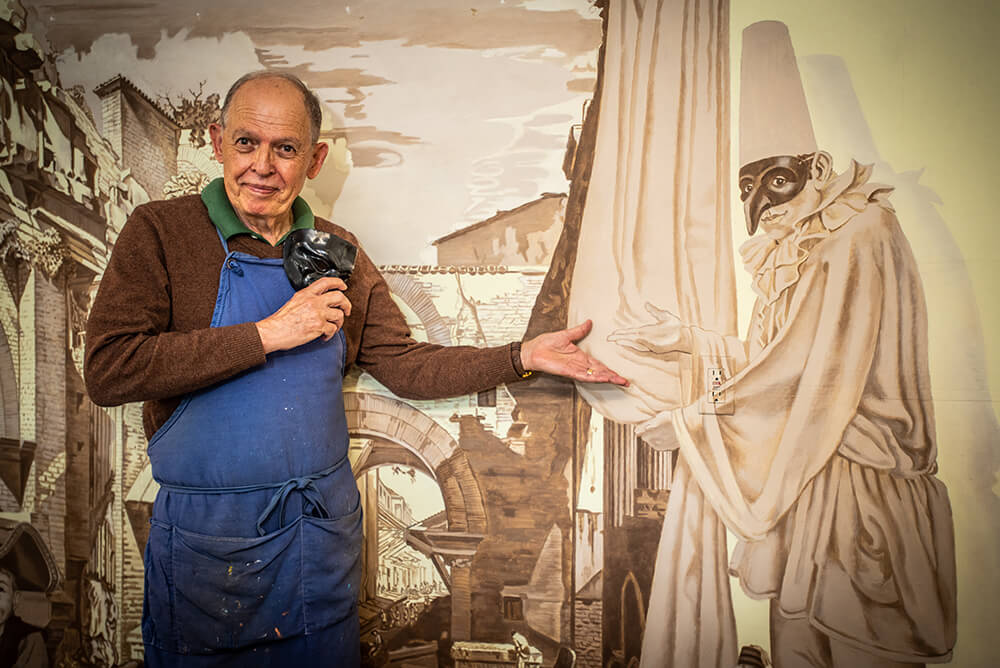
This character you’ve likely started playing “Where’s Waldo?” with goes by the name of Pulcinella. Joseph remembers first encountering the well-known stock character in Italian theater (also called “commedia dell’arte”) at a Pulcinella-packed exhibit at Stanford University. “I was devastated and amazed,” he says. “I’d found my man.”
Over the centuries, Pulcinella has been depicted as both foolish and cunning, both servant and master. He’s an opportunist known for exploiting situations to his favor—yet despite his foibles, rescues others who find themselves in trouble. For Joseph, the character is an ideal vessel for exploring humanity’s many faces. “He’s an everyman,” Joseph describes. “He represents everyone you could be.”
The artist notes that Pulcinella paintings aren’t in as much demand as they once were and that he’s incorporated more landscapes from his travels as well as Bay Area scenery into his practice of late. Though fortunately, he still finds fans of his favorite rogue.

Artwork: Alla Volta; Tea Time.
Joining the conversation, Joseph’s wife Jane references one of her husband’s earlier works: a piece in which Pulcinella shows a barefaced young girl around a mask shop. “Innocence doesn’t have a mask,” says Jane, observing, “As you come of age, you put on many masks. You can become anyone you want.” Joseph nods in agreement, “She’s being initiated into a future world that she’s going to occupy.”
Joseph and Jane
Joseph and Jane interact with that comfortable, lived-in ease that comes after 55 years in a strong marriage. Growing up, they attended the same schools—junior high, high school and college (San Jose State)—but it took two fateful dinners to finally get the two together. The first didn’t go so well.
Joseph, who had joined the military and spent a frigid winter in a guard tower in Korea, was back on leave when he attended a dinner hosted by their mutual friends. “He was white as a sheet, thin, extremely quiet,” Jane recalls. Meanwhile, Joseph found Jane excessively bubbly. “And I don’t like champagne!”
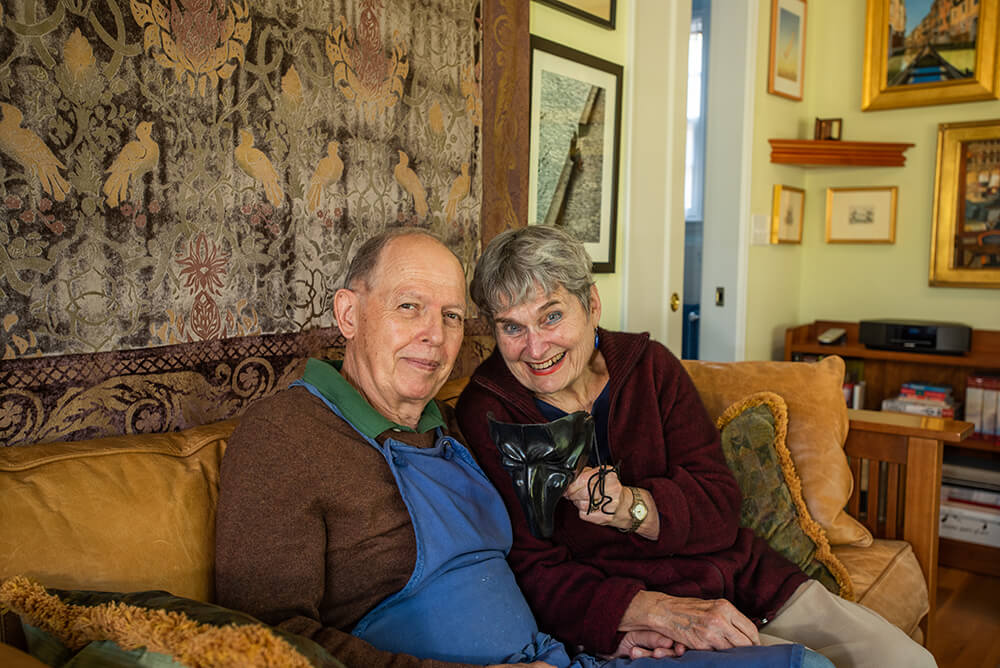
But when the two ate again with the same mutual friends a year later (after Joseph returned from time serving as a medic in Vietnam), sparks flew. “She’d written a couple of letters to me,” Joseph remembers. “And when the door opened, and she said, ‘Joe! Joe!’ It knocked me down! Nobody really had welcomed me back like that.” Jane adds that the change of scenery had done him good. “He was tan, muscular and had this fantastic smile,” she reminisces. “I told my girlfriend after I saw him the second time, ‘I’m gonna marry that man.’ And I’m usually a very cautious person! Within two weeks, we were engaged.”
Outside the Canvas
Drawn to art from childhood (which included many a sketch of Donald Duck), Joseph continued to paint during his time in the military. When he returned to California after ending his tour, he took up teaching at Menlo-Atherton High School with the intention of cultivating the next generation of artists. Instead, he got roped into teaching English, his college minor.
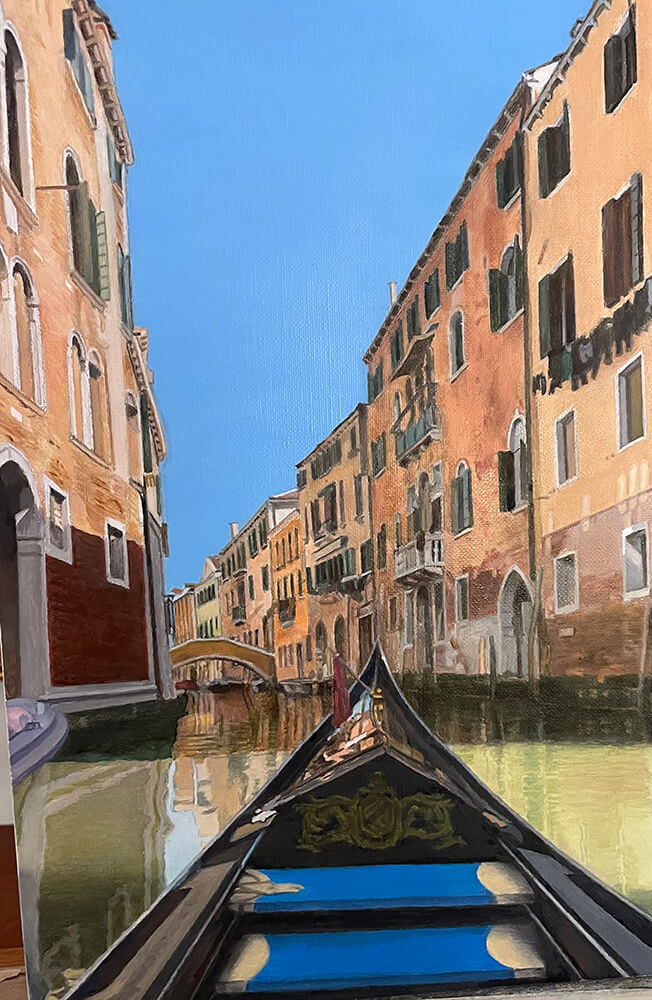
Artwork: A Wizard's Dream
“That didn’t squash the painting,” Joseph assures. “It augmented it because it allowed me to be in a world of ideas… It allowed me to have this kind of imagination that deals with images. Because when I read a book, I’m thinking of images.” And although Joseph didn’t log long hours in front of the canvas during his early years of academia, he still carved out short nightly sessions to paint in the garage—even if only for 15 to 20 minutes.
He also found creative ways to tie art back into his students’ writing prompts. For one project, Joseph handed out images to his students and told them to write short stories that culminated with the pictured scene. For another, they analyzed a film and book version of the same story to find where the tales overlapped. “The kids loved it,” he smiles.
In 1991, when Joseph started exhibiting his art, his students came to show their support. Since then, his work has been displayed at over a dozen galleries and exhibitions including the Pacific Art League, Voshan Fine Arts and (his latest) Gallery 9 in Los Altos as well as international shows like Art Revolution Taipei and Biennale Internazionale Dell’arte Contemporanea in Florence.
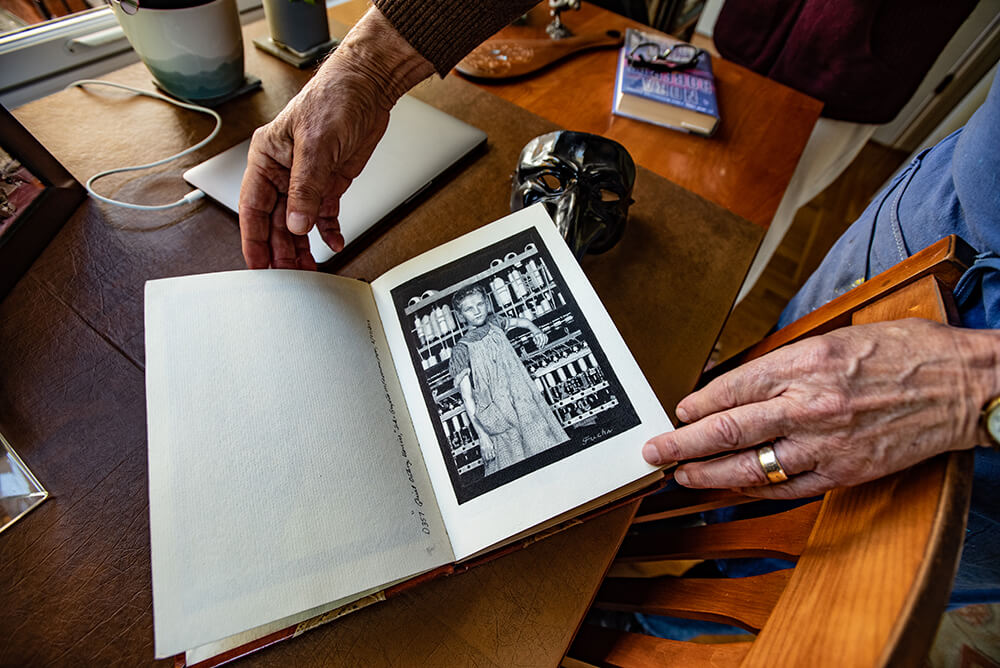
Artwork: Arcadia; English Waif (inspired by a photo of a threader by Lewis Hine).
Now in retirement, Joseph dives into traveling, submerging himself in the inspiration of landscapes from around the world. In addition to wielding a paintbrush, he also renders black and white sketches with a combination of pencil and pen. “When you go from one to the other, there’s a transition,” he notes of the differing mediums. “How do you hold this pencil?”
Back in his home studio, Joseph explains how he balances a painting and pulls the viewers’ attention around the canvas. He indicates a scene with a man unloading a boat, the box in his hands tipping at a precipitous angle. A dozen characters twist around to watch him, waiting for the inevitable. “The interest goes back and forth,” Joseph explains. We watch the unfortunate man, but also the reactions of the watchers. It seems a fitting metaphor for a prolific artist with a multifaceted life.


